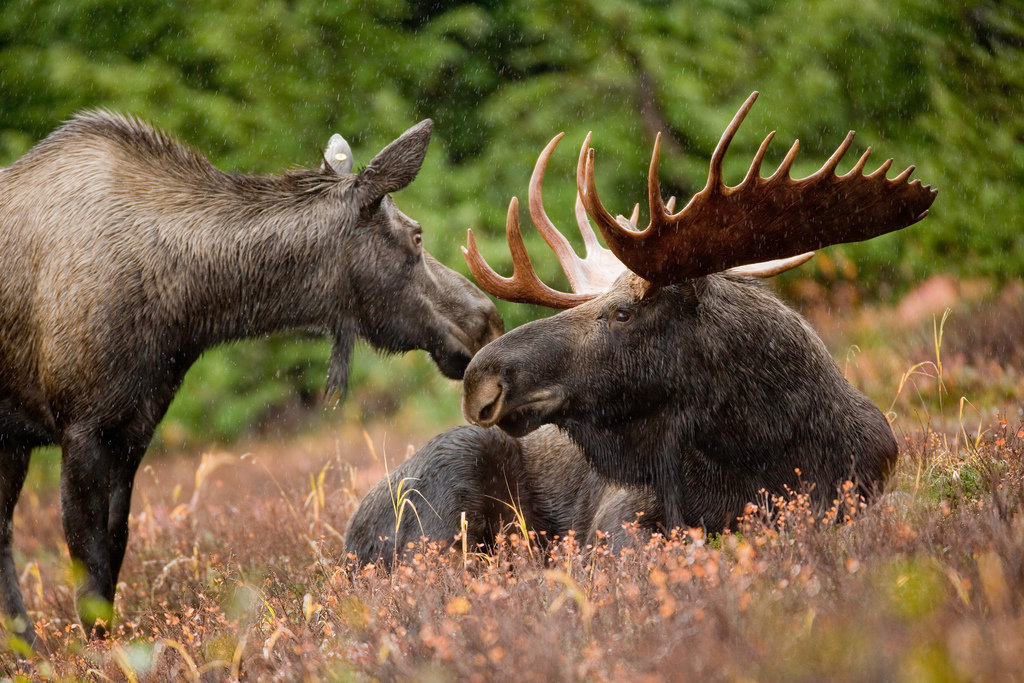Like this article? rabble is reader-supported journalism. Chip in to keep stories like these coming.
If you thought this winter was mild, you’re not the only one. Moose across the country will likely be itching for colder weather next year, thanks to a problematic infestation of winter ticks. The small parasites breed and spread more easily in years with warmer winters. Although they don’t carry any diseases transmittable to humans, they’re known to have an especially large impact on moose populations.
The ticks attach themselves to the animals and feast on their blood, sometimes tens of thousands at a time. The affected moose often suffer from exhaustion and anemia as a result of blood loss, but the worst damage is often done by the moose themselves. The ticks’ constant biting leads them to scratch and groom excessively, often breaking the hairs in their winter coats and leaving them exposed to the cold. Those with the worst infestations can appear predominantly grey — and have been dubbed “ghost moose” by conservationists and hunters alike.
While most moose recover from the infestation, a significant number end up dying, particularly the young. And with this warm winter, it seems likely there will be more in the years to come.
Bill Samuel, a parasitologist, has been studying winter ticks for more than 30 years. He says ticks typically drop off of moose in March and April, after feasting throughout the winter. “If ticks drop on snow, often crusted in March, they cannot get to the duff layer and they die,” he says.
This premature death ensures the ticks won’t reproduce. However, it’s not the only advantage to cold weather. An early winter in the fall gives the moose another leg up on their persistent pests. “If winter comes early with cold and snow, the transmission period is reduced, thus decreasing the number of ticks that will get on moose that year,” says Samuel. “So in short, yes it appears that milder winter weather, of which we have had lots in recent years, is good for ticks, not good for moose.”
Though recent studies have shown their detrimental effect on moose populations, winter ticks aren’t a new problem. Samuel can recall hearing about them as early as the 1970s. “While hunting moose in the early 1970s in northern Alberta I met a local who was wise to what was happening in the wild,” he says. “He told me about ghost moose and how he would watch moose with thousands of ticks groom against them, using their hind hooves to scratch their necks and sides.”

A ghost moose suffering from severe winter tick infestation. Photo courtesy of Bill Samuel.
But although the ticks have been around for a while, their increasing prominence has led to renewed efforts to quash the infestation before it’s too late. In New Hampshire, the ticks are already having a devastating effect. Last year, Kristine Rines, a biologist working for the state’s fish and game department, told the CBC winter ticks were “the major mortality source” for the state’s diminishing moose populations.
In Quebec, government biologists have confirmed the percentage of moose carrying the ticks has climbed to 93 per cent in the area below the St. Lawrence River. British Columbia is monitoring tick populations annually, and has asked residents to fill out a tick survey. The results will be used to develop an index of infestations over time.
Though winter ticks are often linked to declining moose populations, they don’t exclusively prey on the species. However, while other animals like deer and mules have established some natural defenses against the parasite, moose seem uniquely susceptible.
Samuel says this is partly due to moose’s inability to adapt to the parasites. He likens the relationship between ticks and moose is an arms race, where both animals develop mechanisms to outmaneuver with the other. “Usually this co-evolutionary ‘arms race’ works well, and there is equilibrium between parasite and host,” he says. “That is what happens in white-tailed deer. But moose appear not yet to have evolved the necessary defense mechanisms to co-exist with the parasite. Moose often over-winter with 35,000 or more ticks; we find that deer usually have less than 500.”
According to Samuel, it’s not the moose’s fault for not adapting quickly enough. Ticks likely evolved on deer or their ancestors, whereas moose only came to North America 10,000 years ago and haven’t had the same long-term exposure.
It seems unlikely they’ll have an opportunity to make up the time. With many climate scientists predicting warmer winters, ticks may be in for increasingly favourable winters –leaving moose little time to recover. For now, it seems the winter tick problem will remain an itch that just can’t be scratched for these iconic animals.

Jen Halsall is studying journalism and history at Carleton University in Ottawa. She also makes very small, very cute terrariums and sells them on the Internet. She is rabble’s 2015-16 blogs intern.
Like this article? rabble is reader-supported journalism. Chip in to keep stories like these coming.




